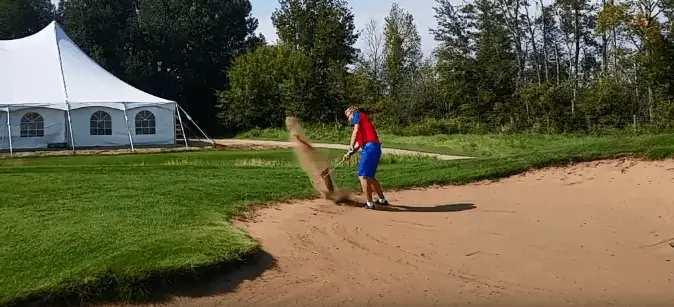Golf Rules: A Quick Reference Guide

Golf can be a confusing game for newcomers, especially when it comes to understanding the rules.
In this quick reference guide, we’ll cover the basics of golf etiquette, how to handle out-of-bounds and lost balls, what to do in water hazards and sand traps, and how to play the ball as it lies.
We’ll also discuss relief from obstructions and interference, as well as penalty strokes and disqualification.
By the end of this article, you should have a better understanding of the rules of golf and be ready to hit the course with confidence.
The Basics of Golf Etiquette
Golf is a game of tradition and etiquette, and it’s important to follow proper protocol on the course. Here are some basic guidelines to keep in mind:
- Always be respectful of other players and the course. This means not making loud noises, fixing divots, and raking bunkers.
- Play at a reasonable pace. Don’t hold up other players or cause delays by taking too long to hit your shot.
- Allow faster groups to play through. If you’re holding up other players, it’s common practice to let them pass.
- Replace divots and repair ball marks on the green. This helps keep the course in good condition for all players.
- Observe the proper dress code. Most courses require collared shirts and prohibit jeans and metal spikes.
- Keep quiet when others are hitting. This includes not talking or making noise that could distract other players.
Out of Bounds and Lost Balls
When a ball goes out of bounds or is lost, it can be a frustrating situation for a golfer. Here’s what to do in these circumstances:
- Out of bounds: If a ball goes out of bounds, the player must hit another ball from the spot where the original shot was played. This shot counts as a stroke, and the player must also add a penalty stroke to their score.
- Lost ball: If a player can’t find their ball after searching for it for a reasonable amount of time, they must hit another ball from the spot where the original shot was played. This shot also counts as a stroke and adds a penalty stroke to the player’s score.
It’s important to be aware of out-of-bounds areas and hazards on the course, as these can significantly impact your score if you’re not careful.
By understanding the rules for out-of-bounds and lost balls, you can avoid costly penalties and keep your score in check.
Water Hazards
Water hazards are designated by yellow or red (depending on the course) stakes or lines, and include rivers, streams, lakes, and other bodies of water.
If a ball enters a water hazard, the player has several options for how to proceed:
- Play the ball as it lies in the hazard:
This means taking a shot from within the hazard, but the player is not allowed to ground their club in the hazard or touch the water with their hand or club. This option is often difficult and carries a high risk of losing the ball. - Drop a ball behind the hazard:
This option allows the player to take a shot from a spot on the course that is behind the hazard and equidistant from the hole. This shot counts as a stroke and carries a one-stroke penalty. - Drop a ball within two club lengths of the point where the ball crossed the hazard line:
This option allows the player to take a shot from a spot on the course that is closer to the hole than the point where the ball crossed the hazard line. This shot counts as a stroke and carries a one-stroke penalty.
Playing the Ball as It Lies
One of the core principles of golf is to play the ball as it lies, which means taking your shot from the spot where the ball comes to rest after it has been hit.
This rule helps to ensure a fair and level playing field for all players.
Here are some guidelines to keep in mind when playing the ball as it lies:
- You may not move the ball to a better lie:
If the ball comes to rest in a difficult spot, such as in a divot or behind a tree, you must play the ball from where it lies. You may not move the ball to a more favorable spot on the course. - You may move loose impediments:
You are allowed to remove loose impediments from around the ball, such as twigs, leaves, and stones. However, you may not improve the lie of the ball by moving it or altering the course.
Relief from Obstructions and Interference
Sometimes, the course or other players can create obstructions or interference that make it difficult to take a shot.
In these cases, players are allowed to take relief from the obstruction or interference in order to have a fair chance at playing the hole. However, in most cases, this will require taking a drop and adding a penalty stroke to your score.
Here are some common situations where relief is allowed:
- Obstructions: Players are allowed to take relief from temporary obstructions without penalty, as long as they do not improve the lie of the ball. This means they can move the ball to a spot within one club length of the nearest point of relief, which is the spot on the course that is nearest to the ball but not closer to the hole. However, free relief is not given for permanent structures on the course.
- Interference: Interference occurs when the ball or the player’s stance, swing, or line of play is affected by an object. If the object is a temporary structure, players are allowed to take relief from interference without penalty, as long as they do not improve the lie of the ball. However, if the interference is a permanent feature of the course, you will have to take a drop and add a penalty stroke to your score.
Penalty Strokes and Disqualification
Golf is a game of integrity, and players are expected to follow the rules and play honestly. When players violate the rules, they may incur penalty strokes or even be disqualified from the round. Here are some common situations that can result in penalties or disqualification:
- Penalty strokes: Penalty strokes are added to a player’s score when they violate a rule. Some common situations that result in penalty strokes include:
- Hitting a shot out of bounds
- Losing a ball
- Grounding the club in a hazard
- Touching the ground with the club before hitting the ball
- Improving the lie of the ball
- Disqualification: In severe cases, players may be disqualified from the round for violating the rules. Some common situations that can result in disqualification include:
- Signing an incorrect scorecard
- Deliberately altering the course
- Using a non-conforming club
- Violating the rules of amateur status
- Having too many clubs in your bag
Golf is a challenging but rewarding game that requires a good understanding of the rules.
By following proper etiquette, knowing how to handle difficult situations on the course, and playing the ball as it lies, you can enjoy a fair and enjoyable round of golf.
As you continue to learn and improve your skills, it’s important to always be aware of the rules and to play by them.
With practice and patience, you’ll soon be well on your way to becoming a proficient golfer.






